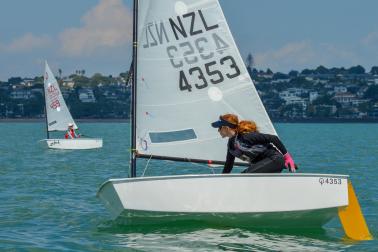Understanding that greater diversity will enhance our sport, Yachting New Zealand have developed a wide-ranging women and girls in sailing strategy to attract more female participants, retain those already sailing and advance equal opportunities.
There are clear inequalities for women and girls when it comes to participation and wider involvement in our sport. Girls make up approximately 20-30 percent of those sailing in New Zealand in the junior classes; by adulthood it drops to 20 percent. Like many sports, sailing loses participants as they progress through adolescence but, for sailing, it means attenuation of an already small pool of females.
We conducted a six-month research project focusing in the first instance on junior and youth sailing. We reviewed the sailing environment, both past and present, and qualitative research was used to gain an understanding of people’s experiences, attitudes, motivations and barriers faced.
While the focus of this research was on females and their experiences, we believe some of the strategies that have come out of the findings are relevant for all sailors.
OUR VISION
Our vision is to advance equal opportunities in sailing
Yachting New Zealand are working to enable women and girls equal opportunities to participate, enjoy and succeed in our sport for life.
FINDINGS THAT HELPED SHAPE OUR STRATEGY
Culture
Networks and support are important for females across all levels of participation, especially given the small proportion of females sailing. Other sports have achieved success by connecting a network of female regional and club representatives to support female athletes. But females are underrepresented in decision making roles in our sport and, like many other sports, female coaches are not progressing through to high-performance positions.
Pathways
There is a lack of clarity and understanding around pathways for women in professional sailing, high-level coaching, leadership positions and marine industry careers. Transitioning between classes can be daunting and there can be uncertainty or little support for sailors in this phase. It’s not helped by the fact there aren’t enough visible role models across all aspects of our sport.
Programmes
The main drivers for junior sailors is having fun and being with friends. Some club programmes, however, place increasing demands on junior sailors. Extensive research has found that working with athletes to help shape quality programmes leads to greater engagement and retention; learning through play accelerates development and decision making; and an athlete’s long-term development and performance is enhanced by engaging in a variety of sports and activities at a young age.
STRATEGIC OUTCOMES
The collective effort of the whole sailing community is required to achieve our strategic outcomes. This includes sailors, parents, coaches, clubs, class associations and Yachting New Zealand.
1. CULTURE - A confident and connected female sailing community.
Our focus:
- Building connections
- Inclusive and capable leadership
- Attract and retain more quality female coaches
2. PATHWAYS - Widespread awareness of the opportunities for females in sailing.
Our focus:
- Greater visibility and understanding of sailing pathways
- Making it easier for sailors to transition between classes
- Identifying and celebrating female role models
3. PROGRAMMES - Encouraging programmes that enable greater participation and engagement.
Our focus:
- A sailor-centred approach
- Building the base of sailors by creating an environment of development and enjoyment
WHAT SUCCESS LOOKS LIKE
- Greater all-round participation
- Programmes that better reflect the needs of females
- More female coaches, race management and leaders in the sport
- Increased retention
- More girls reaching high performance level
- More females working in the industry

